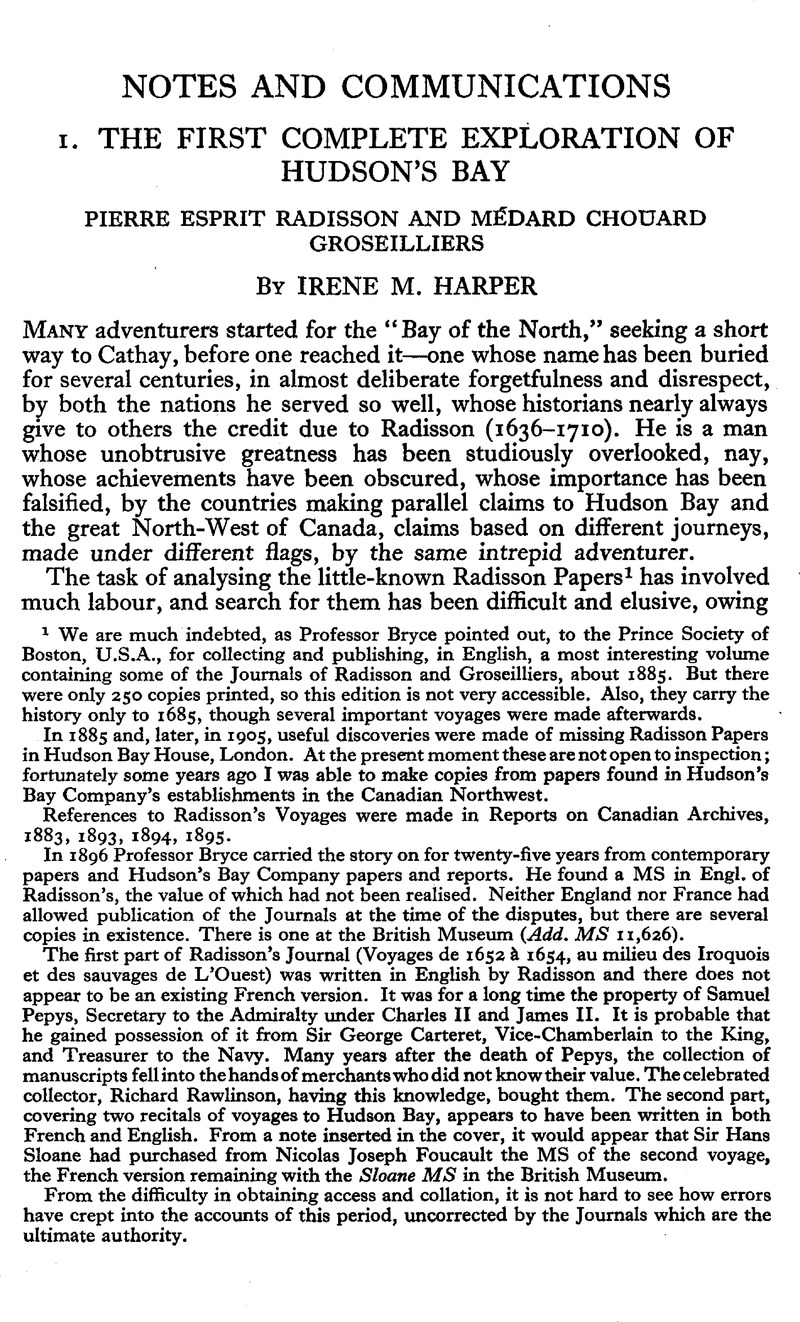No CrossRef data available.
Article contents
I. The First Complete Exploration of Hudson's Bay
Published online by Cambridge University Press: 20 December 2011
Abstract

Information
- Type
- Notes and Communications
- Information
- Copyright
- Copyright © Cambridge University Press 1929
References
page 74 note 1 We are much indebted, as Professor Bryce pointed out, to the Prince Society of Boston, U.S.A., for collecting and publishing, in English, a most interesting volume containing some of the Journals of Radisson and Groseilliers, about 1885. But there were only 250 copies printed, so this edition is not very accessible. Also, they carry the history only to 1685, though several important voyages were made afterwards.
In 1885 and, later, in 1905, useful discoveries were made of missing Radisson Papers in Hudson Bay House, London. At the present moment these are not open to inspection; fortunately some years ago I was able to make copies from papers found in Hudson's Bay Company's establishments in the Canadian Northwest.
References to Radisson's Voyages were made in Reports on Canadian Archives, 1883, 1893, 1894, 1895.
In 1896 Professor Bryce carried the story on for twenty-five years from contemporary papers and Hudson's Bay Company papers and reports. He found a MS in Engl. of Radisson's, the value of which had not been realised. Neither England nor France had allowed publication of the Journals at the time of the disputes, but there are several copies in existence. There is one at the British Museum (Add. MS 11,626).
The first part of Radisson's Journal (Voyages de 1652 à 1634, au milieu des Iroquois et des sauvages de L'Ouest) was written in English by Radisson and there does not appear to be an existing French version. It was for a long time the property of Samuel Pepys, Secretary to the Admiralty under Charles II and James II. It is probable that he gained possession of it from Sir George Carteret, Vice-Chamberlain to the King, and Treasurer to the Navy. Many years after the death of Pepys, the collection of manuscripts fell into the hands of merchants who did not know their value. The celebrated collector, Richard Rawlinson, having this knowledge, bought them. The second part, covering two recitals of voyages to Hudson Bay, appears to have been written in both French and English. From a note inserted in the cover, it would appear that Sir Hans Sloane had purchased from Nicolas Joseph Foucault the MS of the second voyage, the French version remaining with the Sloane MS in the British Museum.
From the difficulty in obtaining access and collation, it is not hard to see how errors have crept into the accounts of this period, uncorrected by the Journals which are the ultimate authority.
page 75 note 1 Report of M. Édouard Richard to Dr Brymner, Dominion Archivist. Canadian Sessional Papers, 1900.
page 75 note 2 At one period (1830–40), owing perhaps to the close connexion with many “factors” and pioneers in the North-West Territories, who wrote the facts, as they learned them, back to their friends, several Scottish compilations were—in part, at least—accurate, see Tytler, and Wilson, , Hist. View of Progress of Discovery of Northern Coasts of America, Edinburgh, 1832Google Scholar. Since that date these errors have crept in again.
page 76 note 1 French Colonial Archives in the Department of Marine begin in 1669. Colbert, the great minister, who had charge of the colonies from 1662, collected and transcribed the principal despatches and instructions relating to the territorial possessions of France beyond the seas. There were now two special registers for the colonies. Colbert, in stimulating the development of these distant establishments, saw that they would become of such importance as to require a distinct centralisation. By 1710, La Compagnie des Indies was self-supporting, and its correspondence was kept in a separate file. In 1770, on the final downfall of the French companies, two departments were created, and from 1791 the Colonial Archives were placed in two collections. Hence it is that there are still to be found in France many documents of the first importance which have so far been overlooked.
page 76 note 2 Similarly, there are documents in the Collections of the Council for Trade and Foreign Plantations and in the America and West Indies Series (merged as far as 1688, then new divisions were made in Colonial Office Records, P.R.O.). See Colonial Entry Books, Students Helps Series, No. 45, 1921. These documents seem never to have been collated. Also see Phillipps MS, 8794 (1687–96), now in the Library of Congress; but another copy was made, probably by one of the secretaries; and a MS copy is in my possession in Cambridge, as well as transcripts of all the important memorials concerning the Hudson's Bay Company, some from that Company's papers collected by me in Canada, others from other MS collections, such as that concerning the Treaty of Ryswick.
page 76 note 3 Crouse, Nellis M., In Quest of the Western Ocean (Dent), 1928, pp. 262–4Google Scholar. On p. 367 there is another error. Groseilliers led the return voyage of the 1669 expedition from Hudson's Bay, as well as the outward voyage to Hudson's Bay. Radisson's ship was storm-bound and compelled to return. It remained a joint venture, however.
page 77 note 1 Radisson's first two voyages, when he was stolen from his birth-place at Three Rivers, Quebec, was tortured, and later adopted by the Iroquois and forced to take part in Indian warfare, and to devise dangerous expedients and escapes, literally prepared him for any emergency of his later voyages. The third voyage (1658–60) was marked by the discovery of the Mississippi; the fourth, by that of the overland route to the Bay of the North; the others with the sea voyages to Hudson Bay.
(Note. There are several different spellings of both names in the Archives and Journals; and that Des Groseilliers is often referred to as Couart or Médard Chouard, giving the impression of a different personality.)
a Radisson's Journal, 1660. Jesuit Relations and Allied Documents, 1610–1791, Vol. 3, of 1660. Translation of seventy-three volumes by Reuben G. Thwaites, commentary by Kenton, E.( Papers of State Historical Society, Wisconsin, 1896).Google Scholar
(Note. In view of the economic clash of interests in the fur trade, which was brought about by the erection of the Hudson Bay forts by the English in 1670, it is interesting to note that the Jesuit Relations were suspended for a time in 1673. These Relations (mere reports, see edition edited by M. de Rochemonteux) were edited in France, and at best present a one-sided picture. Recognition was withheld from any successful enterprise which had not sought their patronage. There is manifest danger in regarding these reports as the only authentic source of early Canadian history.
They took two forms: (a) Private letters and confidential notes, written by the Jesuits in America; (b) Reports, more properly Relations. It is unfortunate that little remains, or is available, of the (a) group. Their sincerity and accuracy would have corrected the (b) group, prepared frankly for publication and glorification. The anti-clerical side (in this case Radisson's) requires the help of the secular correspondence of the period.
(Note. “Correspondance-Générale” between French Government and its representatives in Canada, is not fully collated, though much has been copied for Canadian Archives, q.v.).
page 78 note 1 Laut, A. C., Pathfinders of the West, Toronto (Briggs), 1904.Google Scholar See here also Brymner, “Some Radisson Papers,” Rep. Can. Archives, 1895.
page 78 note 2 Pepys. See also DrDionne, N. E., “Chouart et Radisson,” Trans. Roy. Soc. Can. 1893, 1894.Google Scholar
page 78 note 3 Prof Bryce, Geo., “The Further History of P. E. Radisson,” Trans. Roy. Soc. Can. 1898, p. 53Google Scholar. Benj. Sulte, various publications quoted by Miss Laut, supra. Minutes of the Hudson Bay Company, 6 May, 1685, for copy of Radisson Contract H.B.C. Letter Book, 20 Sept. 1692: “The said King Charles II, giving credit to Radisson for that undertaking, granted to Prince Rupert…under which authority the said Radisson made an English settlement…” “Sir Wm. Young pleaded, that as Mr Radisson was the author of the Company's prosperity…” Notice of Bill in Chancery, Radisson vs. the Hudson Bay Company, filed July 1694. (Sir Samuel Clark “expended £200 for Secret Service (!) in trying to evade same.”) Decision of Chancery Court, ordered payment of arrears and salary.
page 79 note 1 By an Ordinance of 19 Oct. 1676, M. J. Duchesneau, Intendant, called a meeting to consult about fixing the prices of beaver. Among others present were: “Louis Joliet, Médard Chouart des Grozeliers, Charles Le Moyne de Longueil, Robert Cavelier de La Salle, Perre Esprit Radisson, Charles Vazire, Receiver-General of the King's Dues in New France, and Special Agent of Nicolas Ondiett, Farmer of the said dues.” 1676, French Archives, F 2.
page 79 note 2 “Grant of Privilege of establishing a fishery of white porpoise and seal, on St Lawrence, in favour of Sieurs Desgrozeliers and Radisson. Privilege for twenty years of seal fishing off Island of Anticosti only, and of porpoise fishing from the said island as far as Montreal.” 6 April, 1676, French Archives, Series B, vol. 7.
page 79 note 3 “Ordinance of M. de la Barre, grant to Benjamin Guillin (Gillham, Gilham) of Boston, clearance of the Ship ‘Le Garcon,’ now in the port of Quebec, although he had no license or passport from His Brittanic Majesty, permitting him to enter the waters of Hudson's Bay.” 25 Oct. 1683, French Archives, F. 4.
page 79 note 4 “The Minister to M. de Denonville. Would do well to promise young Desgrazeliers that he shall be rewarded with those he brings with him to Quebec. The King will give a reward of fifty pistoles to any and every person who shall succeed in capturing Radisson and bringing him to Quebec.” 6 April, 1685, French Archives, Series B, vol. II.
page 79 note 5 “Ordinance of M. de Meuilles, directing M. Chalons, agent of La Ferme du Canada, to pay M. de la Chesnaye and his associates (except Radisson) for all the beaver brought from Hudson's Bay; and granting to the Farm Company, the right to appeal to His Majesty.” 8 Nov. 1683, French Archives, F. 4.
page 79 note 6 “Old-Timer” is the term applied throughout the New World to the first explorers and settlers.
page 79 note 7 Royal ordinances and memorials dealing with Radisson and Groseilliers recur with such frequency in the Archives of England and France from c. 1660 to 1729 that we must come to a very different conclusion to that of Garneau, Crouse and others. It becomes increasingly evident that their movements had a profound importance in the minds of those responsible for colonial administration, and especially those concerned with the economics of the fur trade. The mean way in which both countries defrauded these two brave men of their just dues takes on a more sinister light as we realise the importance of the fur trade. The learned editor of the “Jesuit Relation” remarks that “Even in the 16th C. the fur trade was more important to France than the fisheries; and it caused huge discussion in France.” Rivals had the rapacity of vultures. The treasury could not bear the cost of the armaments which France undertook; and so she charged the commanders for them and allowed them to reimburse themselves by whatever profits they could make. She paid inadequate salaries to the governors, and closed her eyes to the peculations they committed.

